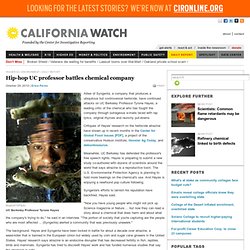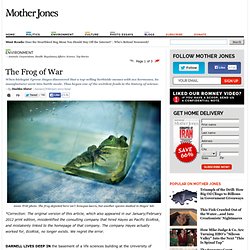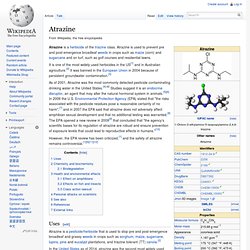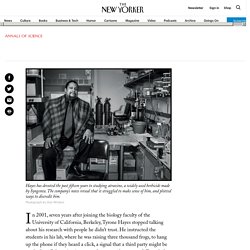

Hip-hop UC professor battles chemical company. Noah2415/FlickrUC Berkeley Professor Tyrone Hayes Allies of Syngenta, a company that produces a ubiquitous but controversial herbicide, have continued attacks on UC Berkeley Professor Tyrone Hayes, a leading critic of the chemical who has fought the company through outrageous e-mails laced with rap lyrics, original rhymes and raunchy put-downs.

Critiques of Hayes' research on the herbicide atrazine have shown up in recent months in the Center for Global Food Issues [PDF], a project of the conservative Hudson Institute, Hoosier Ag Today, and debunkosaurus. The Frog of War. The Frog of War. Annie Tritt photo.

The frog depicted here isn't Xenopus laevis, but another species studied in Hayes' lab. *Correction: The original version of this article, which also appeared in our January/February 2012 print edition, misidentified the consulting company that hired Hayes as Pacific EcoRisk, and mistakenly linked to the homepage of that company. Did Berkeley Defund a High-Profile Pesticide Researcher?
Tyrone B. Hayes. Broadcast Yourself. Integrative Biology (@IBatBerkeley) sur Twitter. Atrazine. Atrazine is a herbicide of the triazine class.

Atrazine is used to prevent pre and post-emergence broadleaf weeds in crops such as maize (corn) and sugarcane and on turf, such as golf courses and residential lawns. It is one of the most widely used herbicides in the US[1] and in Australian agriculture.[2] It was banned in the European Union in 2004 because of persistent groundwater contamination.[3] As of 2001, Atrazine was the most commonly detected pesticide contaminating drinking water in the United States.[4]:42 Studies suggest it is an endocrine disruptor, an agent that may alter the natural hormonal system in animals.[5][6] In 2006 the U.S. However, the EPA review has been criticized,[1] and the safety of atrazine remains controversial.[1][6][11][12] Uses[edit] Atrazine is a pesticide/herbicide that is used to stop pre and post-emergence broadleaf and grassy weeds in crops such as sorghum, maize, sugarcane, lupins, pine and eucalypt plantations, and triazine tolerant (TT) canola.[2]
Atrazinelovers home page. Univ_of_CA-7-19-10. Berkeley Syngenta Response. Bringing plant potential to life - Syngenta AG. Syngenta Nederland. The Frog of War. Chemische bestrijdingsmiddelen in verband gebracht met grote bijensterfte. Strategien, die Syngenta erwog, um einen kritischen Forscher einer kalifornischen Universität ruhig zu stellen. Im Rahmen eines Gerichtsverfahrens, bei dem es um die Säuberung atrazin-belasteter Gewässer in den USA ging, musste Syngenta vor einigen Jahren Einblick in Akten und Korrespondenz gewähren.

Vor kurzem wurden sie nun auch der Öffentlichkeit zugänglich gemacht. Eine Journalistin des 100Reporters-Netzwerks hat sie ausgewertet. Ihr Fazit: der Konzern habe eine „aggressive Multi-Millionen-Dollar-Kampagne“ gestartet, um Kläger zu entmutigen und negative Berichterstattung über seine Agrochemikalien zu vermeiden. Pest Control: Syngenta’s Secret Campaign to Discredit Atrazine’s Critics. To protect profits threatened by a lawsuit over its controversial herbicide atrazine, Syngenta Crop Protection launched an aggressive multi-million dollar campaign that included hiring a detective agency to investigate scientists on a federal advisory panel, looking into the personal life of a judge and commissioning a psychological profile of a leading scientist critical of atrazine.

The Switzerland-based pesticide manufacturer also routinely paid “third-party allies” to appear to be independent supporters, and kept a list of 130 people and groups it could recruit as experts without disclosing ties to the company. Recently unsealed court documents reveal a corporate strategy to discredit critics and to strip plaintiffs from the class-action case. Greenpeace entert Syngenta-Gebäude - News Basel: Stadt. Greenpeace macht Syngenta für das weltweite Bienensterben mitverantwortlich.

Mit einer Guerilla-Aktion in Basel machen die Umwetschützer nun auf das Problem aufmerksam. 1/5 Mit einem riesigen Banner am Syngenta-Gebäude in Basel fordert Greenpeace ein umfassendes Verbot bienenschädlicher Pestizide, als wirksamen Schritt gegen das Bienensterben.Bild: Greenpeace Artikel zum Thema Korrektur-Hinweis Melden Sie uns sachliche oder formale Fehler. Rachel Aviv: The Scientist Who Took on a Leading Herbicide Manufacturer. In 2001, seven years after joining the biology faculty of the University of California, Berkeley, Tyrone Hayes stopped talking about his research with people he didn’t trust.

He instructed the students in his lab, where he was raising three thousand frogs, to hang up the phone if they heard a click, a signal that a third party might be on the line. Other scientists seemed to remember events differently, he noticed, so he started carrying an audio recorder to meetings. “The secret to a happy, successful life of paranoia,” he liked to say, “is to keep careful track of your persecutors.” Three years earlier, Syngenta, one of the largest agribusinesses in the world, had asked Hayes to conduct experiments on the herbicide atrazine, which is applied to more than half the corn in the United States. When Corporations Attack. Libsyn. DN! JUAN GONZÁLEZ: Now we turn to the story of a University of California scientist who discovered that a popular herbicide may have harmful effects on the endocrine system.

Tyrone Hayes was first hired in 1997 by a company that later became agribusiness giant Syngenta. They asked him to study their product, atrazine, a pesticide that is applied to more than half the corn crops in the United States and widely used on golf courses and Christmas tree farms. But after Hayes found results that the manufacturer did not expect, that atrazine causes sexual abnormalities in frogs and could cause the same problems for humans, Syngenta refused to allow him to publish his work. This was the the start of an epic feud between the scientist and the corporation.